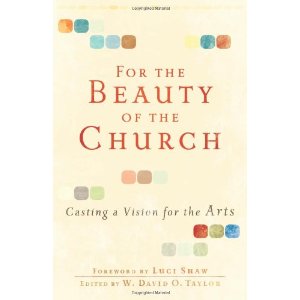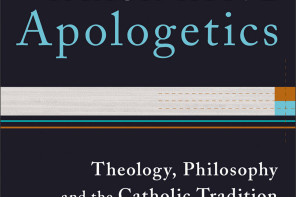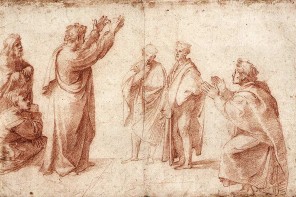Review of Chapter 3 in For the Beauty of the Church. Transpositions is hosting reviews of each chapter of this book between Aug 2 and Aug 9, 2010.
In this essay, Lauren Winner considers what might be one of the most concrete applications of the church’s engagement with the arts – that of being its financial supporter. As a casual art-buyer herself, Winner considers art-buying for the Christian and the wider issue of the church’s engagement with the arts, making several interesting and engaging points along the way.
While recognizing the concern that Christians might have in regard to spending money on art at the expense of other things (ie caring for the poor), Winner responds in three ways. First, art-buying is a privilege. It’s a privilege to be able to pay an artist for his/her work (and a privilege that the artist needs to have someone exercise should they flourish as an artist). Secondly, she notes the tension of following a God who became poor but is also the God of abundance who calls us to ‘live out of an ethic not of scarcity, but of abundance.’ At times, we are to extend this abundance to the poor and to other times, to the artist. Winner finishes this section by alluding to the act of gifting one’s local church with art of the local community (71).
Winner argues that despite rhetoric of hostility, North American Christianity has engaged with the arts over its history in a more positive way than might be currently thought. For example, Anglicans in colonial South Carolina built their churches within a theology of beauty, believing that the earthly beauty was a shadow of divine beauty (78). In addition, Sunday School teachers have been using visual art in order to teach children for many years (79). While Winner brings to light areas of church engagement, it’s at this point where I think a more critical assessment of how the arts have been used would have been helpful to the discussion, especially considering how she concludes her essay.
Winner ends by critiquing the current defense of art as useless beauty (art that exists in and of itself, without further purpose) and the justification it finds in the non-utilitarian beauty of a God-created nature. While Winner thinks that this ‘apologia for senseless beauty’ is important because it corrects a reductionism to utilitarian purposes, it is misguided because art does have a purpose. ‘A Christian understanding of art involves a recognition that art does things. In our Christian history, art mattered.’ In the examples considered from history, art had a purpose and therefore had meaning (76-81).
There are two important points that Winner makes that I think are worth exploring further. The first is the challenge she makes to the common assertion that the church has not ‘engaged’ with the ‘arts’. As Winner outlines and examples, art is a part of our scriptural as well as historical tradition. In our rhetoric about the lack of engagement between art and the church, Winner challenges us to consider both what kind of art we’re referring to as well as what engagement looks like. As my colleague pointed out recently, could a justified rejection be considered an engagement? This essay made me wonder if we’ve been blinded to areas of engagement by an insufficient definition of what ‘art’ is.
The second point for consideration is related to the first. In the history of North American Christianity, the church engaged with the arts from a position of understanding how it fit in with its theology. As a result, art looked differently in different churches. Art as an expression of theology meant that art was useful, meaningful, and purposeful, providing the basis for a church’s engagement (and by extension, investment). The debate rages about whether art is useful or useless and I really appreciate Winner’s perspective that even when art is not utilitarian (I think an important distinction from useful), it does serve a purpose even if that purpose is to adorn God. What I fear in this essay is that the kinds of examples that Winner cites, especially art for devotional purposes or art for didactic teaching, are the reasons why artists are appealing to art being useless. While this is church engagement, surely it limits the potential of art to reveal rather than just illustrate. Is the movement to uselessness necessary to correct an over-emphasis on what is not useful but utilitarian? I think what Winner proposes is a reminder of the connection between usefulness and the ‘abundance of meaning’: ‘the beautification of the commandment itself becomes a place where God reveals himself to us—if only we take the time to linger there’ (81). That which is beautiful is useful because it leads us to revelation. If this is the case, then the church must seriously consider financial investment of the arts, precisely because of what it contributes.






Thanks for this post on Winner’s essay. It really pulls together her main points nicely, and I think you raise some interesting questions at the end. I am especially interested in how “we’ve been blinded to areas of engagement by an insufficient definition of what ‘art’ is.” I wonder if, for example, we have been blind to ways in which the church supported and engaged in the domestic arts (knitting, sewing, cooking, etc.) because modern philosophy of art tended to exclude those as legitimate arts. It could be especially relevant today because of the growing virtual community of craft bloggers that definitely has some spiritual overtones.
I also wonder if it would have been helpful in Winner’s essay if she had distinguished within the category ‘didactic art’ how artists can employ sign, symbol, allegory, and metaphor. It seems to me that these are all different things (though, I admit, I am not all that knowledgeable on this topic), and that these might ‘teach’ people in different sorts of ways. In particular, I am thinking that signs tend to have definite referents (though, I imagine that even a sign can point to more than one thing), but a metaphor tends to open our imaginations and suggest possibilities to us. I suppose I am wondering what sort of distinctions can be made within the category ‘didactic art.’
Thanks again for the post. Her essay is one of my favorites!
“I also wonder if it would have been helpful in Winner’s essay if she had distinguished within the category ‘didactic art’ how artists can employ sign, symbol, allegory, and metaphor.”
I agree Jim. I bristle a little at the rejection of all kinds of art (including visual and literary) on the basis of ‘didactic’. Didacticism is an area of great interest for me, especially in relation to literature’s role in moral and spiritual formation. I wrote a post about the definitions of didacticism a few months ago if you want to take a look – http://goannatree.blogspot.com/2009/11/didacticism-when-definition-makes-all.html
Bascially though, in Literary criticism (as i dare say in the rest of the arts) didacticism is almost a bank-handed insult; to call a work didactic is to say it lacks aesthetic value. I am convinced there are different kinds of didacticism. What lies at the heart of how a piece of literature, film, or visual make both consitute good art in the terms of their form as well pointing to ‘the real’ of which Jeremy Begbie speaks in Voicing Creation’s Praise,
“Whatever else ‘Christian art’ is, it will be art which takes for its final ‘realistic’ reference-point the raising of the crucified Son of God from the dead.”
is something that seems intangible but for which various exemplars can be found and identified. It is apparent to me that there is no one single way in which to point to this real within the context of ‘the story’ – I speak here of the varying work of authors such as C.S. Lewis, J.R.R Tolkien, Dorothy Sayers, G.K. Chesterton, T.S. Eliot, Marilynne Robinson, Charles Williams, Madeline L’Engle, Michael O’Brien, to name but a few.
Here is one definition of didacticism:
1. the practice of valuing literature, etc., primarily for its instructional content.
2. an inclination to teach or lecture others too much, especially by preaching and moralizing.
3. a pedantic, dull method of teaching. — didact, n. — didactic, adj.See also: Learning the views and conduct of one who intends to teach, often in a pedantic or contemptuous manner, both factual and moral material.
I think if something is art, then it can be didactic and just because it is didactic does not necessarily make it bad art. Good art is good art whether or not it is didactic. Didacticism itself does not negate a piece of art being good, there’s usually some other reason for it to fail – like a lack of form, skill, or creativity.
Moralizing dressed up as fiction, or a painting will never be good art.
Sara, thanks for your fine summary. All I’ll say now is this. I’d like to devote considerable energy over the next decades of my to helping the church recover a culture of patronage. Next to clear-headed thinking, the virtue of charity and Christ’s final consummation of all things, I think that’s the most important factor. It is, at least, with regard to a full-fledged–dare I use this language?–renaissance of the arts within Protestantism. If Protestants need a total makeover, then a culture of patronage will be riding shotgun in the proverbial 1965 Chevy C-10 bench seat truck that will help make that happen.
Thanks, David, for your comment! I agree with you that patronage is important for the church to think deeply about and recover. In September, I’ll start a PhD to that end… I look forward to continuing the conversation!
Sara, do you know whether Witvliet’s Institute of Christian Worship still offers grants? I was thinking about how this might relate to church patronage. I look forward to your posts about patronage, the arts, and the church.
I agree all around, and I’d add that patronage is also well positioned to drive education about art in our churches. People that begin to buy art, generally begin to become more and more curious about what it is they’re buying. Then they support more. It’s a win-win!
Jim, regarding the didactic: I generally take didactic art as referring to objects intended from the start as an implement or support for instruction of some sort. What’s awesome, is that the terms you bring up (signs, symbols, allegories, and metaphors) are an integral part of the idea of representation. You could also add icon and index, to round it out. These are certainly integrally related to didactic art, but are much broader in their application. I figure that any meaningful object (all objects?) can be utilized for teaching, but of course it’s important to distinguish that not all objects are intended for teaching. I think you’re right that an artist that “re-presents” the world to us in a nuanced and compelling way, whatever their representational means (iconic, symbolic, and indexical – with their subsets) is going to facilitate teaching. And I applaud this application of any art, just not this reduction of art. 🙂
For a great, fairly short introduction to the subject, check out “Representation” by W.J.T. Mitchell: http://www.as.ua.edu/rel/secure/rel4801and2mitchell.pdf
Dayton, how would you respond to those who use didactic as an insult? This isn’t a new phenomenon – Nicolosi relies heavily on W.B. Yeats who was a strong advocate of the danger of didacticism and rhetoric in art (especially poetry): “the best lack all conviction, while the worst are full of passionate intensity.”
It is helpful that you brought up icons. I think Icons and stained glass are a great example of art that is didactic at their heart.
Perhaps you could have a “artist seeking patrons” link here at the blog? Artists could have links to their body of work where patrons could ‘squeeze the avocados’ so to speak and make a hook-up?
Dan, how would you suggest we go about your suggestion of connecting artists and patrons? Transpositions is ever evolving. One of the things we’ve been trying to ensure that we do is think and reflect carefully on all that we do here and not just to get traffic or be controversial.
Anna, I think more often the language of didacticism is used in a critical way, as opposed to an insulting way or a simply descriptive way. So my first response would be to take the accusation as criticism, not as insult. And criticism is good — the lifeblood of any artist. I also think that a lot hinges on who attaches the adjective to the work. Ironically, many artists speak about their work in a way that exposes it as didactic in nature (“In this work I am trying to illustrate…”), but would bristle at the criticism of didacticism, and perceive it as an insult.
Didactic art can be employed for teaching, but is generally not going to surprise us, frustrate us, or make us wonder. Art that surprises us, frustrates us, and makes us wonder, however, can almost always be employed for teaching. In the case of the latter, the artist must relinquish a little control, and give the work a little of its own freedom. Giving a work of art freedom (his mind echoes with L’Engle and Sayers), means running the risk of misinterpretation — and of an artist being surprised and confronted by their own work. However, in the atmosphere of an embattled Orthodoxy within the church, I think many artists are just not willing to risk their having their theological convictions misinterpreted. Either that, or an artist may lack a nuanced understanding of their own faith. Ergo, tightly constrained declarations of meaning, and use of subject matter. I say let’s learn our stuff, and then run the risk of being branded heretics.
Then, again, the didactic may be done right. I’d love to see it. I do agree with David Taylor’s assertion, mentioned in Jenn’s recent post, that “[a] work is artistically excellent if it accomplishes the purposes for which it was created. In our case, the merit of an artistic work in the church is determined by its context.”
While I think that in many cases, if not most cases, didacticism in contemporary art makes for fairly uninteresting art, if not outright boring art, it should be clearly understood that banal didacticism is NOT simply a problem among Christians. I’m thinking right now of the oil Pumpjack in Millenium Park, Chicago, painted with a desert camouflage scheme. It effectively and immediately conjures the notion of “war for oil,” but little else. It lacks the suggestive, open-ended flexibility that a good work of art will embody. The truth is, most people prefer the didactic (because they can “get it!”), to the Million Dollar Shark.
My big question: Do we need art to attempt to do what words do? I’m an artist, right? Why didn’t I respond to this post by creating a work of art to illustrate my ideas regarding didacticism? Images and words both have their ideal arenas for operation, and neither functions quite as well doing the other’s job (with all appropriate apologies and qualifications to poets, and to the guy that draws the Ikea furniture assembly diagrams).
I’m convinced that there is no magic formula for creating art that is accessible and challenging, or profound.
re: icon
When I mentioned “icon,” I meant it as a general category — what W.J.T. Mitchell identifies as resemblance, imitation, or mimesis.
I’m not sure I’d refer to the icons of the Eastern or Roman Catholic church as didactic. Not my area of expertise, but I’ve come to understand them as entirely different in a epistemological sense, than most non-Icon paintings, drawings, or sculptures. I suppose this relates to my thoughts on the didactic. I think that in one way or another good art will always generate one form or another of knowledge. I use knowledge in a broad sense — that the creation of or beholding of art always moves in a trajectory toward some form of knowing. The means through which this is accomplished varies. Contemporary western art inclines generally toward the propositional. Icons incline more toward (to use Daniel A. Siedell’s ideas) knowledge as similar to that which is arrived at in prayer. This, I think, qualitatively separates Icons from what we are referring to when we say didactic.
@ Anna, I apologize I wasn’t really being that serious, although now that I think about it, for those artists who are trying to directly engage the money economy, or some counter-alternative, it might be a useful thing. Perhaps artists with specific projects in mind that only lack money could be given space to explain their vision and needs? (administered through a respected institution like yours). I think this post on “Patrons” is interesting because I spend a fair amt. of time thinking about art in relation to economy. I find a lot of art discourse avoids that relationship and it becomes an subtext for a lot of what passes as art-speak. I sponsored an art show about 12 yrs ago called the “Stock Market Show,” to draw attn. to this relationship. I sold stock etc. and the profits were shared between artist and shareholders, etc.. Let me add the polemical manifesto I wrote (which was in part, a critique of Guy Debord and Dave Hickey) for the show:
Stock Market Art: A work of art is a commodity. Art is fashioned through the selection and arrangement of pre-existing elements circulating within an administered, visual inventory. The monetary value of art work increases as the art/artist is able to attract interest/capital by garnering the social investment of one or more of a complex of constituencies (mass consumers, patrons, galleries, media, academic institutions). In commodity culture the accumulation of Capital (money, labor, information, celebrity, etc.) until it forms an image, produces spectacle; ‘fine art’ is spectacle representing itself in sublime form. A share of stock, like other currency (or art) has no intrinsic value. Rather, stocks or money as abstractions, mediate our commitments, our faith, and our investments among interdependent (though unequal) systems of culturally constructed realities. Stocks, like grace, are public visible signs of private, invisible assets. the dependence of the arts superstructure on the economic base is often elided in promoting art’s other functions: decoration, moral instruction, dis-interested aesthetic pleasure, class position, and perhaps most significantly providing power/capital with an impotent, institutionally controlled, avantgarde functioning as a relief and diversion from any actual and consequential challenge to it’s authority. The stock market art show was conceived, in part, to make apparent the matrix of relations among visual culture and money culture. but. rather than attempting another superficial critique, this project exposes the sublation of the interests of capital in artistic production and expects to profit from it!
So, Is patronage an alternative to the commodity model or just a more subtle expression of it? In as much as visual aesthetics are constructed within commodity culture in what way is what y’all call “Christian art” different in this respect than…’non-Christian art?’ (are these categories even sustainable, should they be?). In what ways would Church investment in art not become just part of a religious marketing strategy (is that a bad thing?) that already dominates so much of what is called “church building” here in the USA. To touch on Dayton’s comment: “…I do agree with David Taylor’s assertion, mentioned in Jenn’s recent post, that, “…[a] work is artistically excellent if it accomplishes the purposes for which it was created. In our case, the merit of an artistic work in the church is determined by its context.” why should the “purpose” of a work of art determine it’s “excellence?” Ain’t we just going round and round again to intentionality? How do I determine a works/artist’s purpose? Who get’s to establish that purpose or judge it’s worth? What was the purpose of all those blond-haired Jesus’s? Can a work of art lose it’s excellence as later evaluations consider it racist propaganda (long after the artist and his intentions are dead) and it’s context is altered? And what constitutes “context,” the wall, the door, the sidewalk, the landscaping, the neighborhood, the ideology of those that financially administer the religious culture? Thanks so much for the great series.
@Dan
1. What you propose exists already: http://www.kickstarter.com/
2. “The stock market art show was conceived, in part, to make apparent the matrix of relations among visual culture and money culture. but. rather than attempting another superficial critique, this project exposes the sublation of the interests of capital in artistic production and expects to profit from it!”
Did this work? Did your artists and your investors profit from it?
@Dayton, Thanks for the link, and I admire your art work btw. Yes, the show ‘worked’ in a couple of ways. The island that i live on has a great multitude of artists, including a dozen glass shops and Chihuly subs etc.. i think it gave occasion for a lot of artists to take some time and think about the ‘artistic industrial complex,‘ the gallery system, and the administration of visual culture via the money economy. However, I have found artists, for the most part, to be very cautious, risk averse, and conservative, (same as in the academy) contrary to the common perception of the valiant prophet raging against the machine. I sold more than a thousand shares of stock at 5 bucks a piece (the stock certificates were little works of art in themselves). After expenses, which were considerable, the shareholders broke even and the artists made some money. I wanted all the artists, about 35, to allow their art to be auctioned with no reserve or base price (there was a month long silent auction), and to have it’s value solely determined by the ‘market,’ alas, only myself and one other artist were wiling to take that risk. The more financially successful the artist was, the less willing they were to take any risks. I have found this to be consistent with every show I sponsor (the “Lost VanGogh” show, The “Icons, Isotypes, and Binary Code” show, and the “Painting/Differance/Errasure” show, etc.). There is talk of doing another ‘Stock Market‘ show this fall, but I am not sure I am that interested in repeating the exercise. I have encouraged others to give it a try, if anyone is interested I would be glad to send them stock certificate templates etc., there are probably some ways to improve the experiment as well. Best, Daniel.